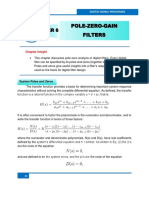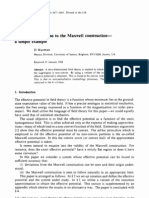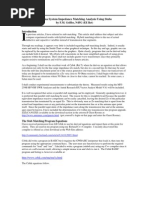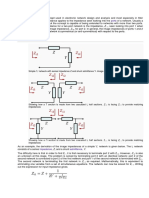Positivee Real Function
Positivee Real Function
Uploaded by
sandy101026Copyright:
Available Formats
Positivee Real Function
Positivee Real Function
Uploaded by
sandy101026Original Description:
Original Title
Copyright
Available Formats
Share this document
Did you find this document useful?
Is this content inappropriate?
Copyright:
Available Formats
Positivee Real Function
Positivee Real Function
Uploaded by
sandy101026Copyright:
Available Formats
Chapter (1): Network Functions and Their Realizability
Lecture (3)
Electronic Circuit (2) ECE 312
Basics of Passive and Active Network Synthesis
13
Chapter (1): Network Functions and Their Realizability
Lecture (3)
Chapter (1)
Lecture (3) Properties of Driving Point (Positive Real) Functions Introduction:
In this lecture we derive some simple properties that all DP functions must have. The properties will apply to impedance and admittance function realized by using some or all of the permissible components. Driving point functions must satisfy the following general properties of network functions: Must be rational functions in s with real coefficients. May not have poles in the right half s plane. May not have multiple poles on the j axis. In addition, since the reciprocal of a DP function is also a DP function, its zeros must satisfy the same constraints as its poles. Therefore, a driving point functions: May not have poles or zeros in the right half s plane. May not have multiple poles or zeros on the j axis. A corollary of the second property is that the degree of the numerator can differ from the degree of the denominator by no more than one. The reasoning is that at infinite frequency (s = j), the terms associated with the highest power of s in the general form of a network function (H(s) is dominating, so that:
Now if n differs from m by more than one, H(s) will either have a multiple pole (n > m) or a multiple zero (m > n) on the imaginary axis, at s = j. Positive Real Function: Passive networks contain no energy sources and as such they can only dissipate - but not deliver - energy. This dissipative nature of passive networks imposes a further restriction on the DP function. The restriction is that if the function is evaluated at any point on the j axis, the real part will be nonnegative. Mathematically:
13
Chapter (1): Network Functions and Their Realizability
Lecture (3)
A heuristic argument to justify this statement follows. Suppose the network function has a negative real part at frequency s = j l. Then the function at s = jl can be written as:
We can place a capacitance (or inductance) whose reactance is jX(l) in series with the network (Figure 2.5), to cancel the reactance term in the original circuit. This new network, which is also passive, has impedance:
which is a negative resistance. If we applied a voltage source at this frequency to this network, the network would deliver current to the source, thereby violating the passive nature of the circuit. Thus the network cannot have a negative real part for any frequency on the j axis.
Another property of passive DP functions is that the residues of j axis poles must be real and positive. Summarizing the properties of Positive Real (passive network) function: Inspection test for necessary conditions: It is required that: Y(s) must be a rational function in s with real coefficients, i.e., the coefficients of the numerator and denominator polynomials is real and positive. The poles and zeros of Y(s) have either negative or zero real parts, i.e., Y(s) not have poles or zeros in the right half s plane.
11
Chapter (1): Network Functions and Their Realizability
Lecture (3)
Poles of Y(s) on the imaginary axis must be simple and their residues must be real and positive, i.e., Y(s) not has multiple poles or zeros on the j axis. The same statement applies to the poles of l/Y(s). The degrees of the numerator and denominator polynomials in Y(s) differ at most by 1. Thus the number of finite poles and finite zeros of Y(s) differ at most by 1. The terms of lowest degree in the numerator and denominator polynomials of Y(s) differ in degree at most by 1. So Y(s) has neither multiple poles nor zeros at the origin. There be no missing terms in numerator and denominator polynomials unless all even or all odd terms are missing. Test for necessary and sufficient conditions: Y(s) must be real when s is real. If Y(s) = p(s)/q(s), then p(s) + q(s) must be Hurwitz. This requires that: i. the continued fraction expansion of the Hurwitz test give only real and positive coefficients, and ii. the continued fraction expansion not end prematurely. In order that Re Y(j) >= 0 for all , it is necessary and sufficient that
have no real positive roots of odd multiplicity. This may be determined by factoring A(2) or by the use of Sturm's theorem.
13
Chapter (1): Network Functions and Their Realizability
Lecture (3)
The inspection test reveals no obvious defects. Poles and zeros are clearly in the left half plane (from the quadratic formula), so that the residue test need not be carried out. It is only necessary to carry out the test: Re Y(j) >= 0 for all
This function is always positive or zero and the function is positive real.
13
Chapter (1): Network Functions and Their Realizability
Lecture (3)
is slightly more complicated, but still passes the inspection test requirements. The poles are seen to be at s = +jl. The Hurwitz test is successful.
The real part test shows that:
which is always positive or zero as required. function F(s) is positive real.
All of the tests are successful and the
13
Chapter (1): Network Functions and Their Realizability
Lecture (3)
13
Chapter (1): Network Functions and Their Realizability
Lecture (3)
13
Chapter (1): Network Functions and Their Realizability
Lecture (3)
13
Chapter (1): Network Functions and Their Realizability
Lecture (3)
34
Chapter (1): Network Functions and Their Realizability
Lecture (3)
33
Chapter (1): Network Functions and Their Realizability
Lecture (3)
33
Chapter (1): Network Functions and Their Realizability
Lecture (3)
31
Chapter (1): Network Functions and Their Realizability
Lecture (3)
Assignment:
(1)
Find the number of real zeros of the following function using Sturm's theorem:
(2)
Test the positive reality of the following function by testing its real part using Sturm's theorem:
33
You might also like
- Focus Smart Plus Maths M2 Teacher GuideDocument67 pagesFocus Smart Plus Maths M2 Teacher Guideพัสกร ครากกระโทกNo ratings yet
- M 116 Lecture NotesDocument259 pagesM 116 Lecture NotesMaycoEstimar0% (1)
- Chapter - 3: Elements of Realiazability Theory: Requirements Is Called Network SynthesisDocument4 pagesChapter - 3: Elements of Realiazability Theory: Requirements Is Called Network Synthesisnandakishore.nalla100% (1)
- Circuits & Systems (ELEC 2209) Network Functions: Ns Rs EsDocument3 pagesCircuits & Systems (ELEC 2209) Network Functions: Ns Rs EsRbqhacNo ratings yet
- Chapter 1Document12 pagesChapter 1ERMIAS AmanuelNo ratings yet
- NTW ch-2Document17 pagesNTW ch-2tesnubabaNo ratings yet
- Laboratory Exercise No. 6 Poles and Zeros of A Transfer FunctionDocument10 pagesLaboratory Exercise No. 6 Poles and Zeros of A Transfer FunctionYasmin KayeNo ratings yet
- Ch-4 NTKDocument74 pagesCh-4 NTKhabtamu mamoNo ratings yet
- The IP3 Specification - DemystifiedDocument16 pagesThe IP3 Specification - DemystifiedkuazuNo ratings yet
- What Are Singularity Functions?Document8 pagesWhat Are Singularity Functions?cj cuestasNo ratings yet
- Laboratory Exercise #6Document11 pagesLaboratory Exercise #6Yasmin KayeNo ratings yet
- Network Synthesis ModifiedDocument109 pagesNetwork Synthesis ModifiedPranzal SharmaNo ratings yet
- SchelkunoffDocument8 pagesSchelkunoffjbnh_No ratings yet
- 07 Poles and Zeros of Transfer FunctionDocument33 pages07 Poles and Zeros of Transfer FunctionRyan VasquezNo ratings yet
- Solar Cell PDFDocument4 pagesSolar Cell PDF艾哲No ratings yet
- Townsend, Quantum Physics, CHAP - 5, Ppios of QMDocument24 pagesTownsend, Quantum Physics, CHAP - 5, Ppios of QMElcan DiogenesNo ratings yet
- Agilent Eesof Eda: Matching Network Yin-Yang - Part 1Document10 pagesAgilent Eesof Eda: Matching Network Yin-Yang - Part 1Steven PeñaNo ratings yet
- The Voltage and Current Transfer Ratios of RLC Operator NetworksDocument13 pagesThe Voltage and Current Transfer Ratios of RLC Operator NetworksPriyaNo ratings yet
- UNIT I, II, III, IV, V Notes PDFDocument93 pagesUNIT I, II, III, IV, V Notes PDFThiagu RajivNo ratings yet
- AN-EIS-007Document16 pagesAN-EIS-007babaloohaNo ratings yet
- Poles and Zeros of Transfer FunctionDocument34 pagesPoles and Zeros of Transfer FunctionRyan VasquezNo ratings yet
- Animation Software For The Teaching of Electrical Transmission LinesDocument12 pagesAnimation Software For The Teaching of Electrical Transmission LinessbuesoNo ratings yet
- Pole-Zero-Gain Filters: Chapter InsightDocument13 pagesPole-Zero-Gain Filters: Chapter InsightAldon JimenezNo ratings yet
- Distribution System Short Circuit AnalysisDocument6 pagesDistribution System Short Circuit Analysisshawnr7376No ratings yet
- Complex NumbersDocument12 pagesComplex Numbersadil4083No ratings yet
- Functions and Their ApplicationsDocument21 pagesFunctions and Their ApplicationsAldjon DodajNo ratings yet
- PWR DivDocument122 pagesPWR Divdhan_anjiNo ratings yet
- Chapter 15 Circuit Analysis in The S-Domaun-1Document36 pagesChapter 15 Circuit Analysis in The S-Domaun-1umerNo ratings yet
- Significance of Complex Numbers in Electrical EngineeringDocument4 pagesSignificance of Complex Numbers in Electrical EngineeringMohsin SajjadNo ratings yet
- B.Sc. Physics Question Paper Second SemesterDocument4 pagesB.Sc. Physics Question Paper Second SemesterMuhsina PNo ratings yet
- EisDocument60 pagesEisEdwin AguilarNo ratings yet
- Converging Algorithm For Calculation of Elements Current That Include Effects of Mutual CouplingDocument11 pagesConverging Algorithm For Calculation of Elements Current That Include Effects of Mutual Couplingwww.irjes.comNo ratings yet
- Right Half Plane Poles and Zeros and Design Tradeoffs On Feedback SystemsDocument11 pagesRight Half Plane Poles and Zeros and Design Tradeoffs On Feedback Systemsharis13haris100% (1)
- Exercise Problems of Topic 2Document5 pagesExercise Problems of Topic 2Par VeenNo ratings yet
- S-Plane Bode Plots - Identifying Poles and Zeros in A Circuit Transfer FunctionDocument4 pagesS-Plane Bode Plots - Identifying Poles and Zeros in A Circuit Transfer FunctionTere BinNo ratings yet
- Instaton Model For E&MDocument7 pagesInstaton Model For E&MBosonUpNo ratings yet
- Nuclear Astrophysics: Shawn - Bishop@ph - Tum.deDocument42 pagesNuclear Astrophysics: Shawn - Bishop@ph - Tum.deJ Jesús Villanueva GarcíaNo ratings yet
- Stub MatchingDocument10 pagesStub MatchingEnos Marcos Bastos100% (1)
- Repaso Teoria CircuitosDocument47 pagesRepaso Teoria CircuitosChristian Xavier Merchan PastorNo ratings yet
- Network FundamentalsDocument10 pagesNetwork FundamentalsRohitNo ratings yet
- A Mathematical Formulation of The Equivalence PrincipleDocument6 pagesA Mathematical Formulation of The Equivalence PrincipleAlagu MurugesanNo ratings yet
- POWER SYSTEM NUTRAL GRND FundamentalDocument21 pagesPOWER SYSTEM NUTRAL GRND FundamentalAbhay ShrivastavNo ratings yet
- Circuit Model For Traveling Wave Semiconductor Laser Ampli®ersDocument4 pagesCircuit Model For Traveling Wave Semiconductor Laser Ampli®ersparsulcucoadaNo ratings yet
- Electromagnetic Theory and Waves Unit 3 Step 4Document24 pagesElectromagnetic Theory and Waves Unit 3 Step 4trabajos unad unadNo ratings yet
- App 4 LaplaceDocument6 pagesApp 4 LaplaceRycille AlayanNo ratings yet
- Ladder & Non Ladder NetworksDocument6 pagesLadder & Non Ladder NetworksPrashant Sharma100% (3)
- 2536 TutorialSymmetrical AA 20120724Document98 pages2536 TutorialSymmetrical AA 20120724jbrenner85No ratings yet
- Coulomb's Law and Electric Field Intensity: TextDocument6 pagesCoulomb's Law and Electric Field Intensity: Textanon_930086877No ratings yet
- Electromagnetic Levitation Using MATLAB Real Time Control ToolboxDocument3 pagesElectromagnetic Levitation Using MATLAB Real Time Control Toolboxrobert1234567mNo ratings yet
- Introduction To MatlabDocument25 pagesIntroduction To MatlabLakshay RawalNo ratings yet
- Hybrid Control of Load Simulator For Unmanned Aerial Vehicle Based On Wavelet NetworksDocument5 pagesHybrid Control of Load Simulator For Unmanned Aerial Vehicle Based On Wavelet NetworksPhuc Pham XuanNo ratings yet
- Basics of Impedance Spectroscopy: ( 1% of The Entire Topic!)Document79 pagesBasics of Impedance Spectroscopy: ( 1% of The Entire Topic!)ManoranjanNo ratings yet
- Pole-Zero Plots StabilityDocument9 pagesPole-Zero Plots StabilityNaveen SaiNo ratings yet
- Image ImpedanceDocument16 pagesImage ImpedanceErick Wangila WanyonyiNo ratings yet
- Lab 4-Discrete-Time Filters With FIR Systems Edit1 X 14Document12 pagesLab 4-Discrete-Time Filters With FIR Systems Edit1 X 14Oscar EsparzaNo ratings yet
- Active FiltersDocument11 pagesActive FiltersmakreloadedNo ratings yet
- Complex NumbersDocument12 pagesComplex NumbersvignanarajNo ratings yet
- Understanding Vector Calculus: Practical Development and Solved ProblemsFrom EverandUnderstanding Vector Calculus: Practical Development and Solved ProblemsNo ratings yet
- EEP 773 Telecom Software Lab: 6 September 2014Document10 pagesEEP 773 Telecom Software Lab: 6 September 2014sandy101026No ratings yet
- Telecom Software Lab: Bharti School of Telecom Technology and Management IIT Delhi, IndiaDocument4 pagesTelecom Software Lab: Bharti School of Telecom Technology and Management IIT Delhi, Indiasandy101026No ratings yet
- EC TestDocument107 pagesEC Testsandy101026No ratings yet
- Tally 9.0Document30 pagesTally 9.0sandy101026No ratings yet
- National Human Rights Commission (NHRC)Document1 pageNational Human Rights Commission (NHRC)sandy101026No ratings yet
- 13-22 Theory of EqDocument41 pages13-22 Theory of EqEquation Learning-YTNo ratings yet
- Algebraic ExpressionDocument99 pagesAlgebraic ExpressionRyan BuboNo ratings yet
- M-10-T1-03 Quadratic Equation PDFDocument45 pagesM-10-T1-03 Quadratic Equation PDFAniketNo ratings yet
- Chapter 2-MMWDocument40 pagesChapter 2-MMWCarlaMaeMaquirangNo ratings yet
- Mathematics 7 Module 1 Lesson 2 Polynomials Pre-Requisite Concepts: Constants, Variables, Algebraic ExpressionsDocument3 pagesMathematics 7 Module 1 Lesson 2 Polynomials Pre-Requisite Concepts: Constants, Variables, Algebraic ExpressionsDorrisNo ratings yet
- Afda Vocab Cards 2016Document143 pagesAfda Vocab Cards 2016Hatice A. GürhanoğluNo ratings yet
- DIFFERENTIAL EQUATION 1 (Order and Degree)Document30 pagesDIFFERENTIAL EQUATION 1 (Order and Degree)Amit kumar beheraNo ratings yet
- Asymptote SDocument11 pagesAsymptote SShanthi.VNo ratings yet
- Math 11 Module 1Document14 pagesMath 11 Module 1Marlyn GuiangNo ratings yet
- Gregory Bullock - Algebra in Words Presents WORD PROBLEMS DECODED (2015)Document314 pagesGregory Bullock - Algebra in Words Presents WORD PROBLEMS DECODED (2015)Abhishek Singh100% (1)
- Graphs of Polynomial FunctionsDocument38 pagesGraphs of Polynomial FunctionsEvelyn MaligayaNo ratings yet
- PolynomialDocument8 pagesPolynomialuser-309594No ratings yet
- Beyond The Quadratic Formula PDFDocument245 pagesBeyond The Quadratic Formula PDFTicketing100% (2)
- CollegeAlgebra Chapter2 Polynomials IMG 20140923 0001Document24 pagesCollegeAlgebra Chapter2 Polynomials IMG 20140923 0001Planning OfficeNo ratings yet
- Minimum R CH 2Document1 pageMinimum R CH 2Saad ArshadNo ratings yet
- Grade 10 Maths Short NoteDocument60 pagesGrade 10 Maths Short Notebeletetewodros00No ratings yet
- Multiple Choice. Read The Statements Carefully and Choose The Correct Answer From The Choices. Write Your Answer On The SpaceDocument3 pagesMultiple Choice. Read The Statements Carefully and Choose The Correct Answer From The Choices. Write Your Answer On The SpacePaul Vincent LauretaNo ratings yet
- STEP 2 2023 Examiners' Report and Mark SchemeDocument32 pagesSTEP 2 2023 Examiners' Report and Mark Schemepingpong playerNo ratings yet
- First Final Examination Math Grade 9Document2 pagesFirst Final Examination Math Grade 9Nick Bantolo100% (3)
- Agmon 1964Document58 pagesAgmon 1964CoNo ratings yet
- Class 10 TH Set-A - Answer SheetDocument6 pagesClass 10 TH Set-A - Answer SheetKunal KishoreNo ratings yet
- Fiitjee Polynomials Rmo, Nsejs Theory+QuestionsDocument20 pagesFiitjee Polynomials Rmo, Nsejs Theory+QuestionsIshita PandeyNo ratings yet
- Quadratic Equation AutosavedDocument16 pagesQuadratic Equation AutosavedKim ManzaneroNo ratings yet
- College Algebra ch01Document26 pagesCollege Algebra ch01Suli FlamencoNo ratings yet
- Ix-Revision For Half Yearly 2023Document8 pagesIx-Revision For Half Yearly 2023bhushan.bansal099No ratings yet
- Licensure Examination For Teachers General Education - MathematicsDocument31 pagesLicensure Examination For Teachers General Education - MathematicsJhay B. MagtibayNo ratings yet
- 1 MTN-4Document8 pages1 MTN-4Mon Henry EgnisabanNo ratings yet
- Course Assignments 441 F 09Document2 pagesCourse Assignments 441 F 09John Hendrik FransNo ratings yet






























































































